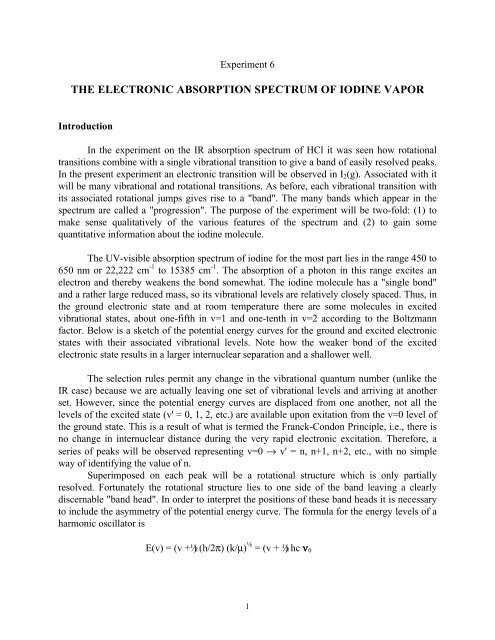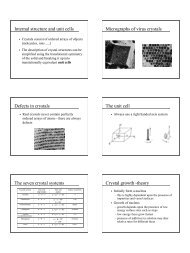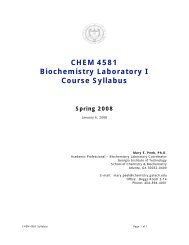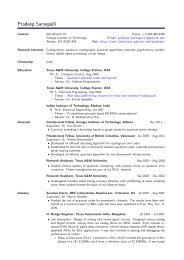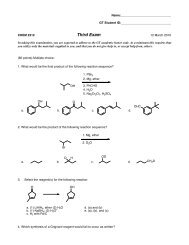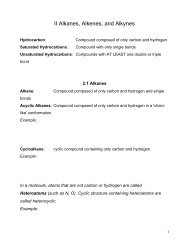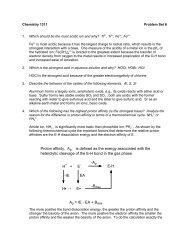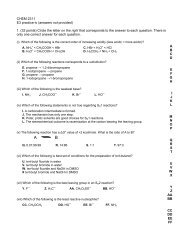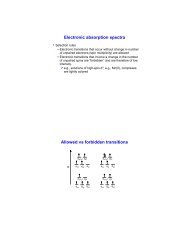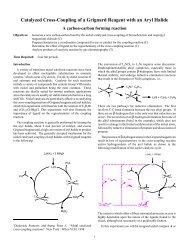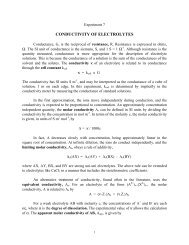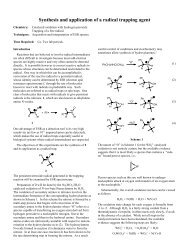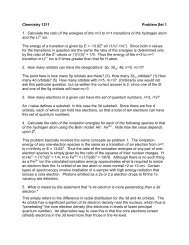Expt. 6 - The Electronic Absorption Spectrum of Iodine
Expt. 6 - The Electronic Absorption Spectrum of Iodine
Expt. 6 - The Electronic Absorption Spectrum of Iodine
Create successful ePaper yourself
Turn your PDF publications into a flip-book with our unique Google optimized e-Paper software.
B( 3 Π 0u + )I( 2 P 1/2 ) + I ( 2 P 3/2 )v’ = m’Excited StateEnergyX( 1 Σ + g )~ν cν~01ν∼00v’ = 1v’ = 0v’ = 2D 0’ D e’∆ν’ ~1∆ν’ ~0ε 0 ’I( 2 P 3/2) + I ( 2 P 3/2)v = mGround StateD 0 D ev = 0r e r e’Internuclear separation(0,m)(0,3) (0,2) (0,1) (0,0)∆ν~ 1 ’ ∆ν ~0 ’Continuum ~ νc ~ ν00cm -12
or, if one measures energy in wave numbers,E(v) = (v + ½) ν 0A formula for an anharmonic oscillator which suffices for our purposes isE(v) = (v + ½) ν - (v + ½) 2 x ν (1)where x is an adjustable anharmonicity constant. In what follows we will ignore changes inrotational energy on the assumption that they do not affect the band heads. <strong>The</strong> excitationv = 0 → v' = n can be broken into two steps,∆E = [(v' = 0) → (v' = n)] + [(v = 0) → (v' = 0)]= ν' (n + ½) - ν' x' (n + ½) 2 - ν' (½) - ν' x (½) 2 + ν (0,0) (2)= ν' n - ν' x' n (n + 1) + ν (0,0)Now consider the dissociation limit <strong>of</strong> the excited state, where the potential energycurve levels <strong>of</strong>f. (Note that the products <strong>of</strong> dissociation are different in the ground and excitedstates. In the ground state the I 2 molecule dissociates into ground state iodine atoms which aredenoted by the term symbol I( 3 P 3/2 ), while from the excited state the molecule dissociates intoone ground state I atom and one atom in the excited spin-orbit state, I( 3 P 1/2 ). Below theground state atoms will be referred to as I and the excited atoms as I*.) <strong>The</strong> dissociation limitis reached in our anharmonic oscillator formula when dE(v')/dv' = 0, say at v' = m'. (<strong>The</strong>formula can't be exact here since it shows E(v') to be turning around rather than approachingan asymptote.) Suppose that in the ground electronic state the dissociation limit is at v = m.We will now break up our transition, v = 0 → v' = m' in the following fashion.∆E = [(v = m) → (v' = m' )] + [(v = 0) → (v = m)]= E(I*) + D O (3)where E(I*) is the energy required for the process I → I*, and D O is the dissociation energy <strong>of</strong>I 2 in the ground electronic state. <strong>The</strong> dissociation energy <strong>of</strong> the excited state can be writtensymbolically asD O ' = [(v' = 0) → (v' = m' )]Thus one can get the two dissociation energies provided one knows (a) the excitation energy<strong>of</strong> the iodine atom (obtainable from atomic spectroscopy), and (b) the values <strong>of</strong> v belonging tothe various band heads <strong>of</strong> the molecular absorption spectrum.3
Bands will also appear for v =1 and 2 → v' = n. <strong>The</strong>se are called "hot bands" because<strong>of</strong> the temperature dependence <strong>of</strong> the Boltzmann factor involved.Mathematical Relations. One can see fairly well the convergence or dissociation limit <strong>of</strong> theprogression <strong>of</strong> band heads on the recorded spectrum. A graphical method for checking thisvisual approach uses the separation <strong>of</strong> adjacent band heads as a function <strong>of</strong> v'. Starting withEqn 2, we write∆(∆E) = ∆E(v = 0 → v' = n + l) - ∆E(v = 0 → v' = n)= ν' -2 ν' x' (n + l) (4)Accordingly, we plot ∆(∆E) versus v' + 1; extrapolation to the v' axis yields anexperimental value <strong>of</strong> m'; the slope is –2 ν'x' and the intercept is ν'. <strong>The</strong> dissociation limitmay be calculated now from Eqn 2, whose constants we have determined, except for ν'(0,0).Pick any band and use its experimental energy in Eqn 2 to evaluate ν'(0,0). Now substitute v'= m' in Eqn 2 to get the required dissociation limit.Experimental<strong>The</strong> spectra will be taken on a Shimadzu UV-Visible spectrophotometer. <strong>The</strong> I 2sample will be contained in a temperature controlled cell and a second, empty cell can be usedto run the experiment in a double beam configuration. <strong>The</strong> instructor or TA will direct you inobtaining the spectra and controlling the experimental temperature.Calculations<strong>The</strong> correction <strong>of</strong> wavelength to vacuum is probably smaller than the uncertainty inlocating a band head; it amounts to adding about 0.14 nm to the recorded wavelengths. Forthe same reason we are not suggesting the calibration <strong>of</strong> the spectrophotometer wavelengthscale against a known standard.Proceed as follows.1. Find the convergence limit at about 500 nm. Follow this back until theprogression <strong>of</strong> band heads disappears into a new progression. This progressionis the one for v = 0 → v' . Find the band head closest to 546 nm. <strong>The</strong> expertshave found by devious means that this corresponds to v' = 25. Mark it so, andproceed to label all the other members <strong>of</strong> this progression with the appropriatev'. You will see that the progression disappears before you get to v' = 10. Donot bother with those indistinct bands close to the dissociation limit.4
2. Determine the wavelength in nanometers to two decimal places for eachlabelled peak as per the directions for the spectrophotometer. Ask yourinstructor for an opinion <strong>of</strong> how to best locate the band head positions.3. For each v calculate the separation in wavenumbers between the v' and v' + 1band heads. Plot "separation" versus v' + 1, in accord with Eqn 4. Scatter inyou plots may be due to interferences from hot bands that are sometimespresent under certain bands.4. From your plot, determine ν', x', ν(0,0), and ν(0, m' ).5. Calculate D O ' the dissociation energy <strong>of</strong> the excited electronic state.6. E(I*), the separation <strong>of</strong> the dissociation limits <strong>of</strong> the ground and excitedelectronic states, is known from atomic spectroscopy to be 7599 cm -1 . Use thisto find D O ' the dissociation energy <strong>of</strong> the ground state.7. In the ground electronic state, v =0 → v = 1 corresponds to 213 cm -1 . Find afew prominent peaks <strong>of</strong> the next progression, add 213 cm -1 to their measuredfrequencies and see if you land on peaks in the first progression. If you do, youwill have identified v' for these new peaks, which represent v = 1 → v'.8. Can you find a third progression at even longer wavelengths? This wouldprobably be the series v = 2 → v'.Illustrative Problem<strong>The</strong> transition v = 0 → v' = 25 is at 546.2 nm. Given that ν' = 128 cm -1 , ν' x' = 0.834cm -1 , and v=0 → v = 1 is 213 cm -1 , find the wavelength for v = 1 → v' = 24.Answer: 555.3 nm5


